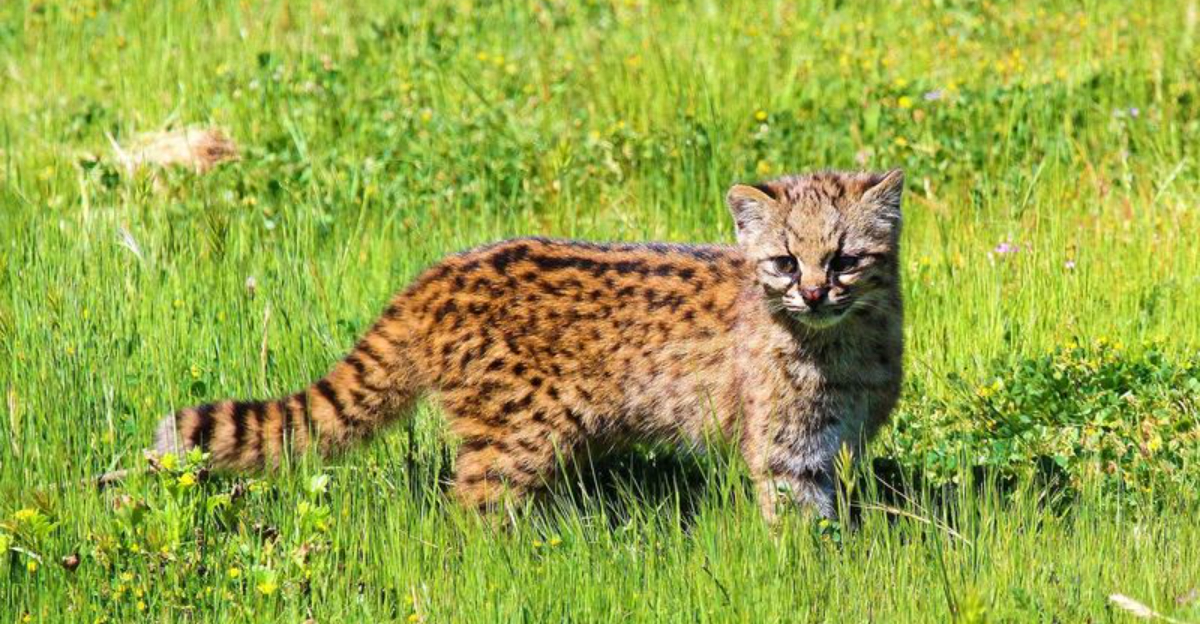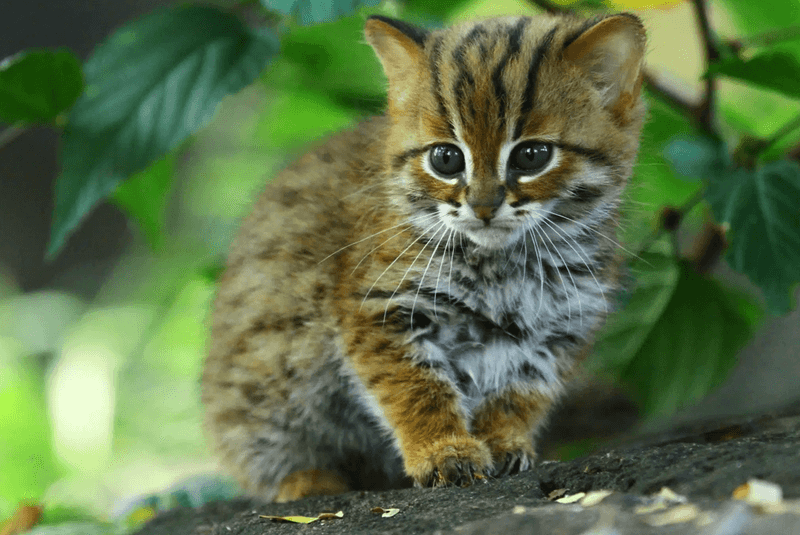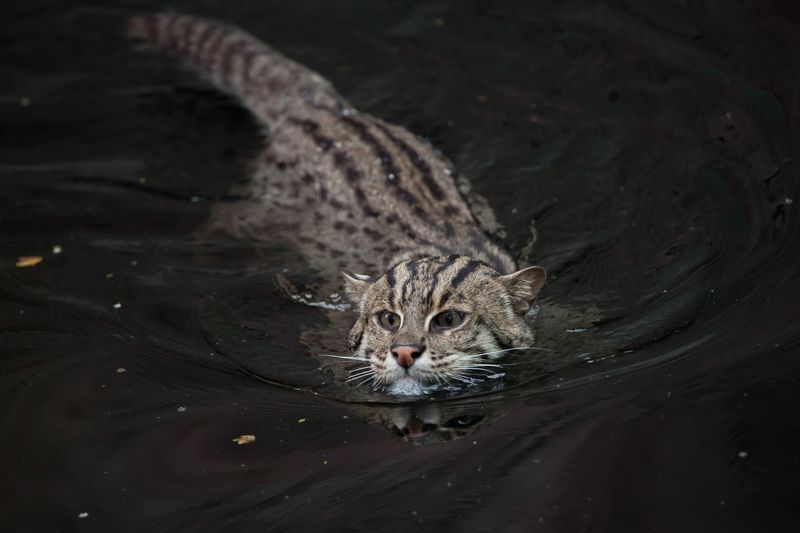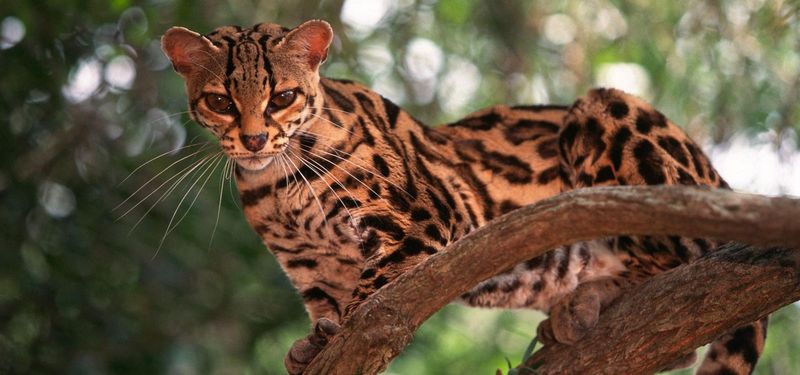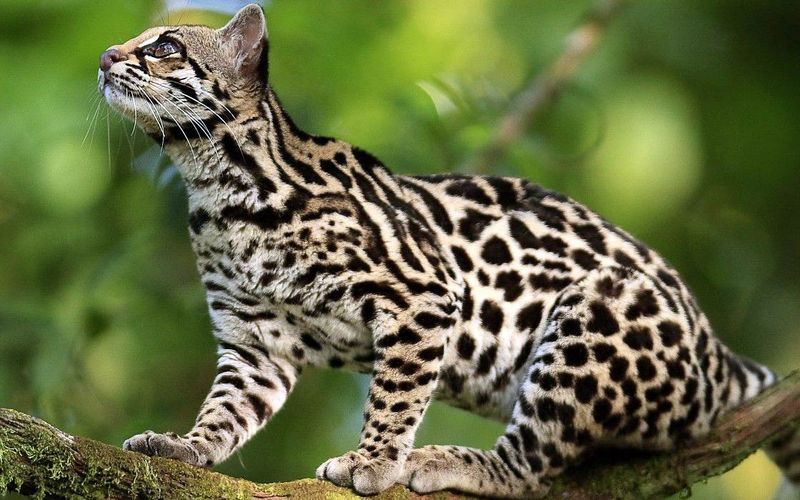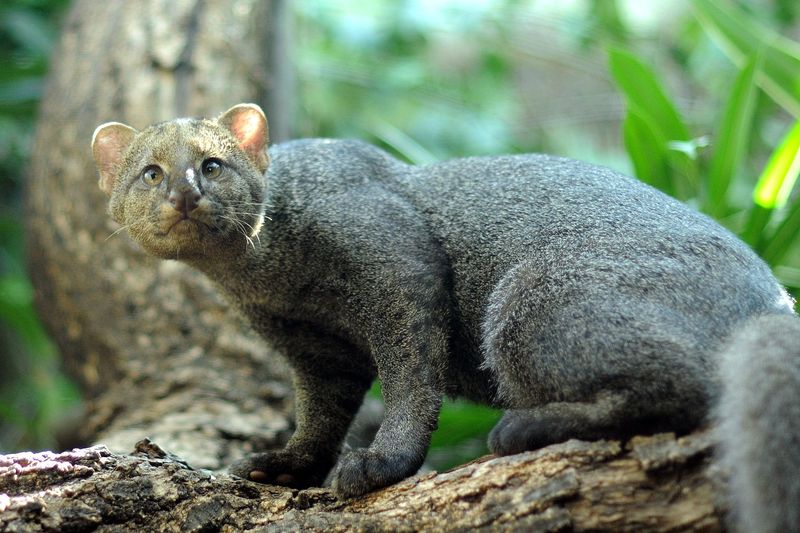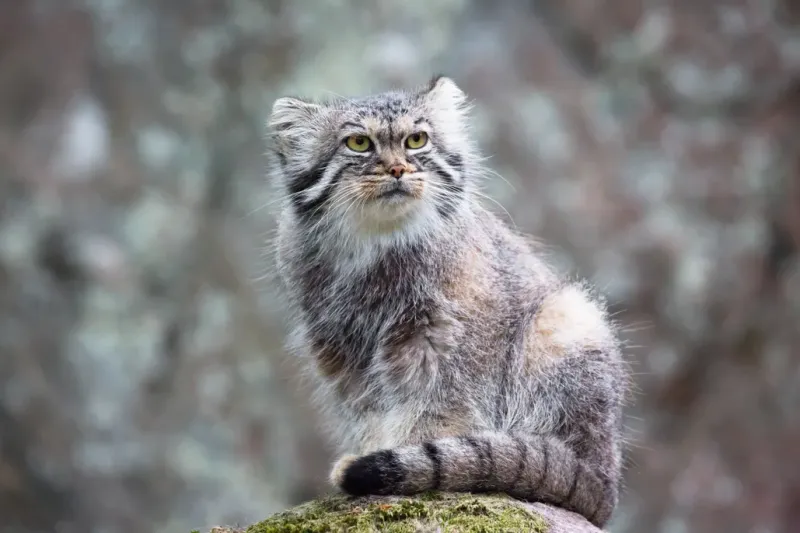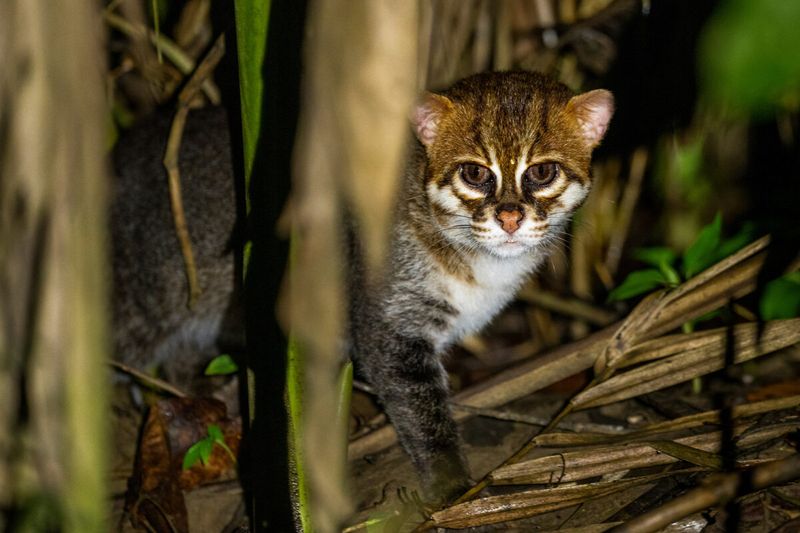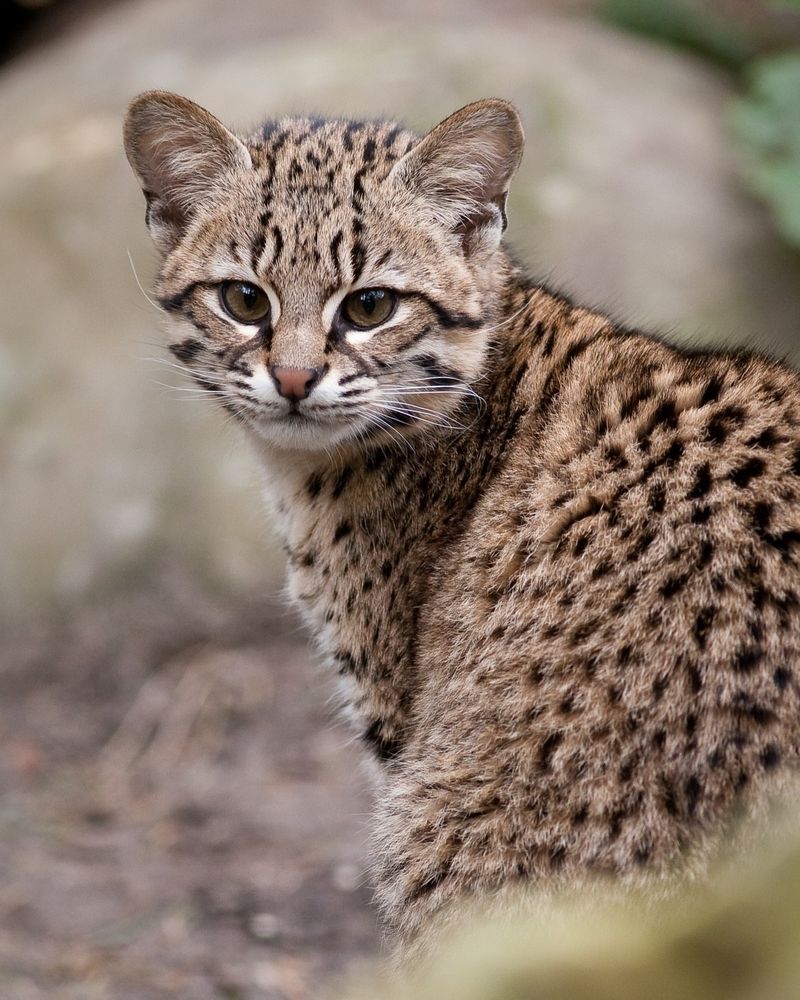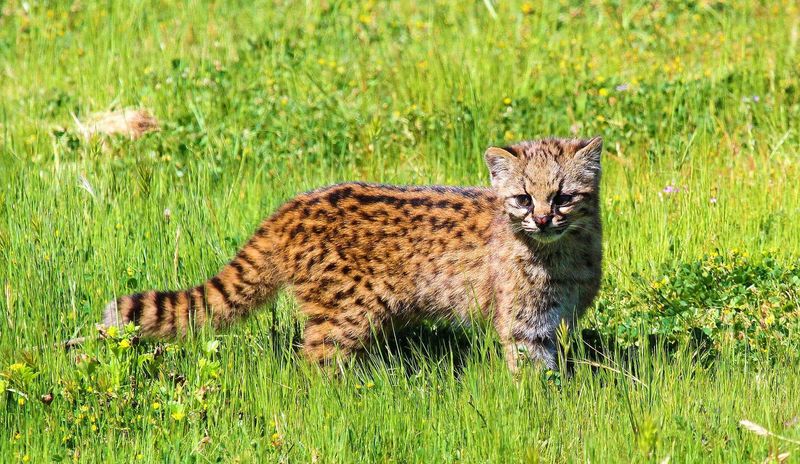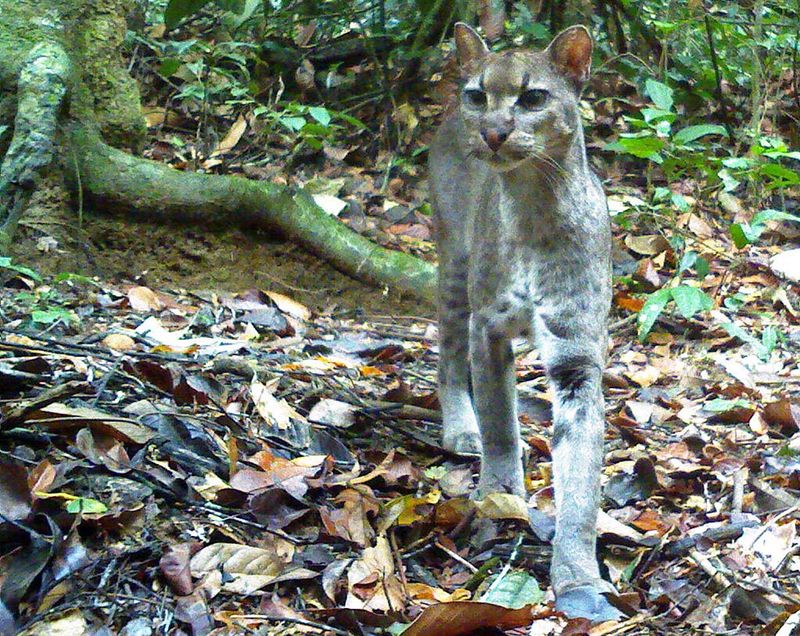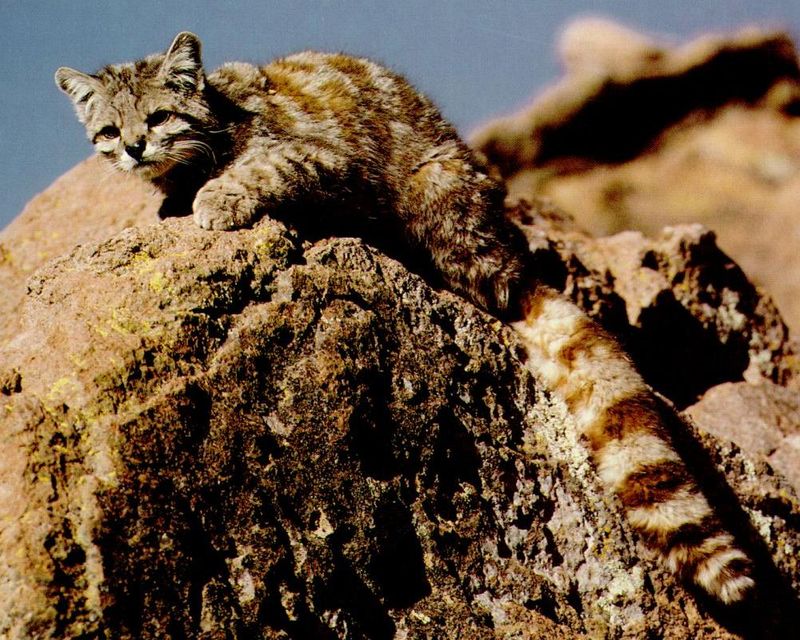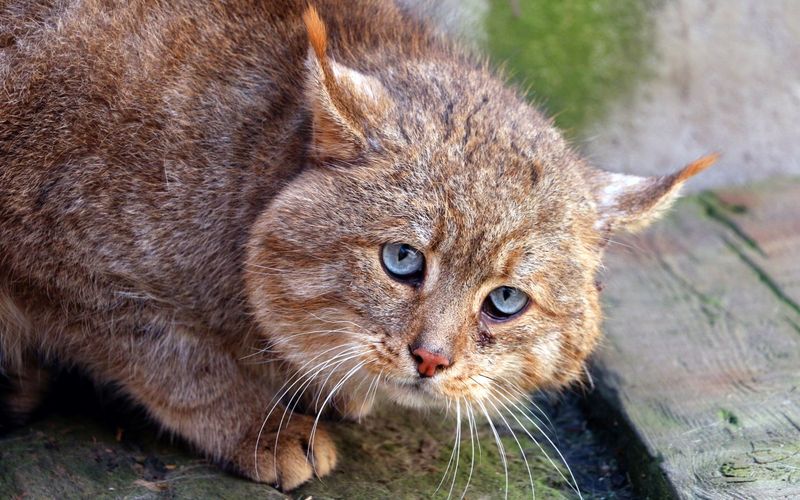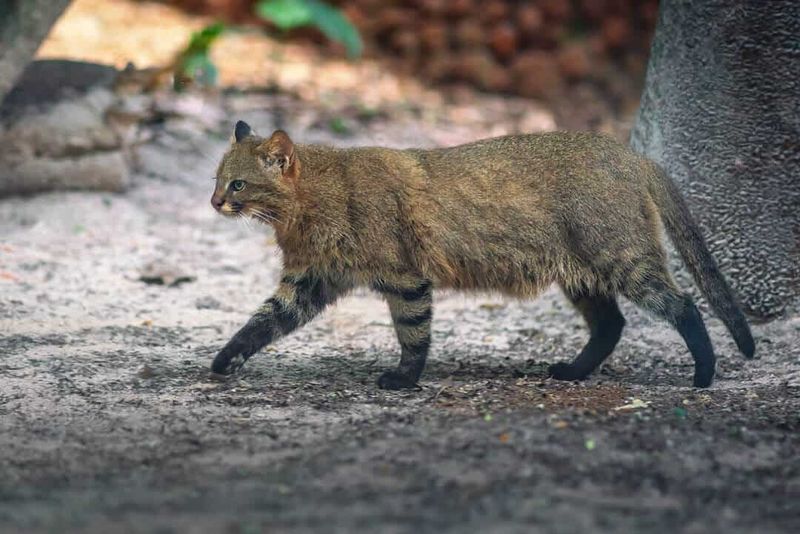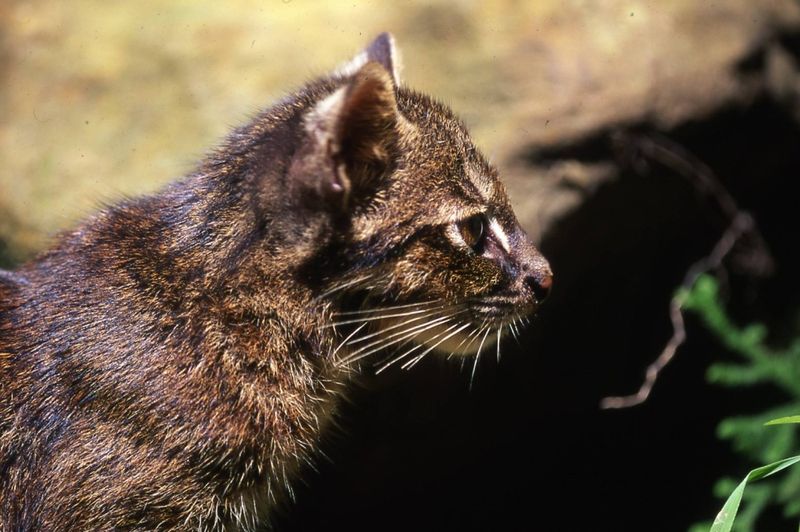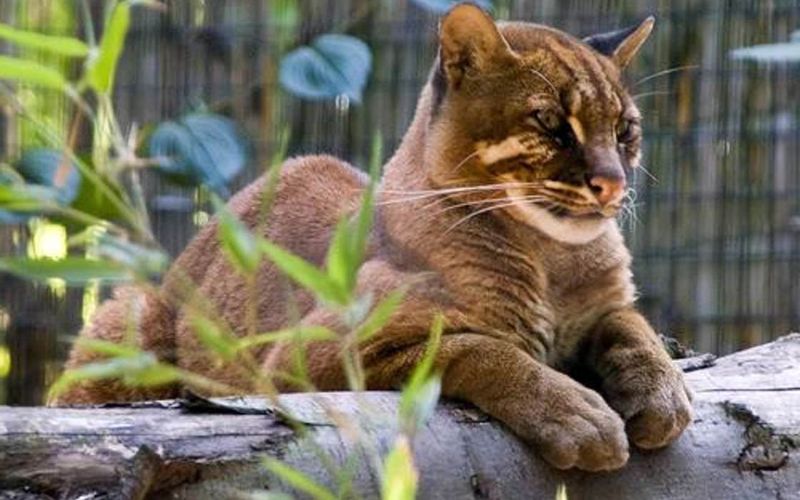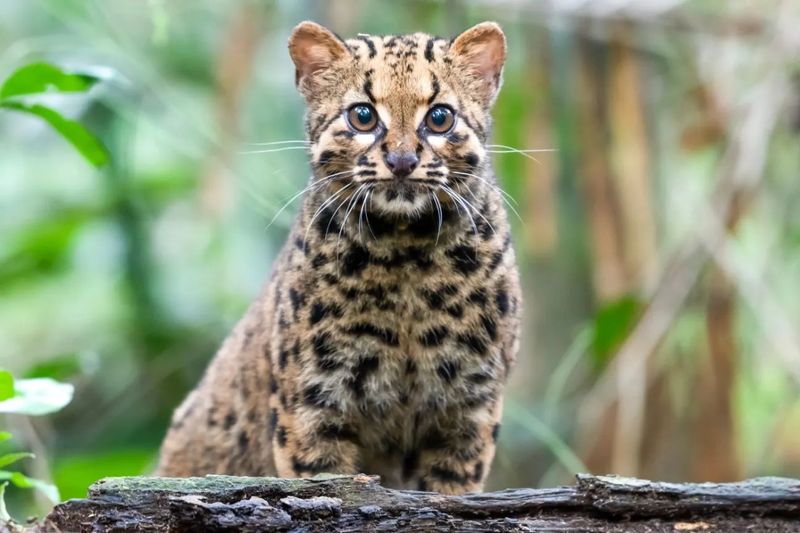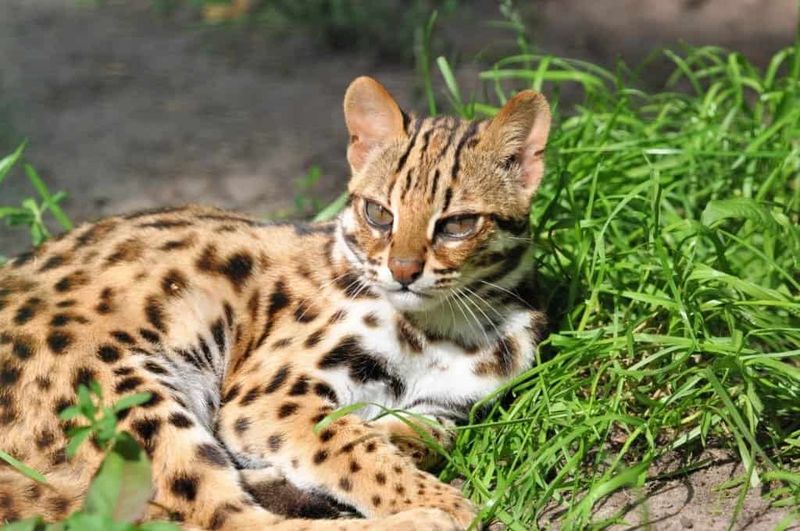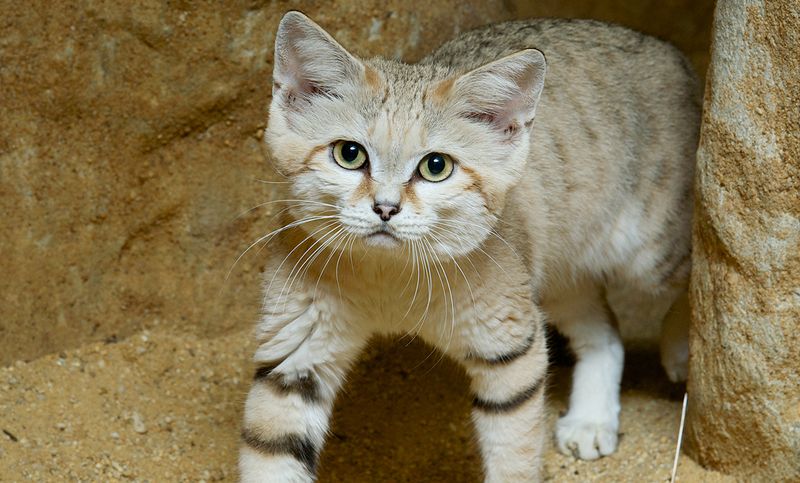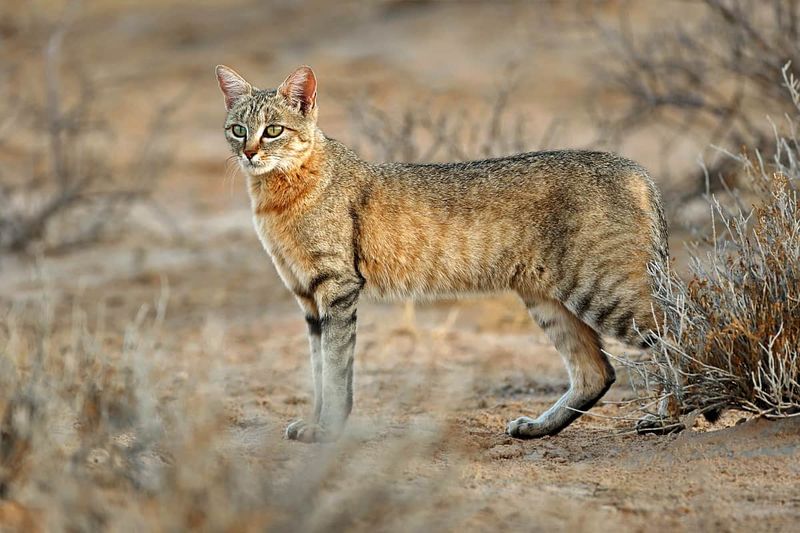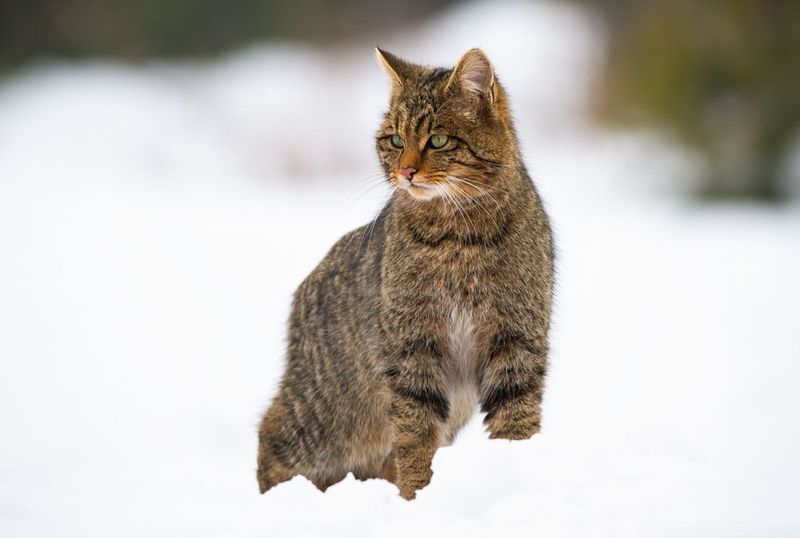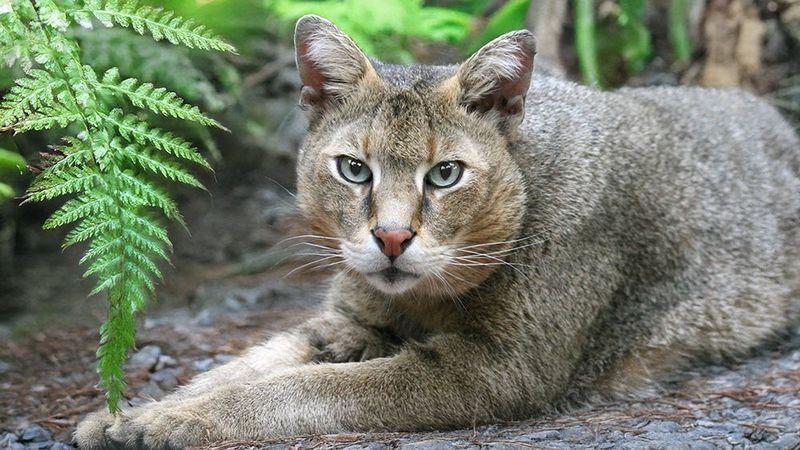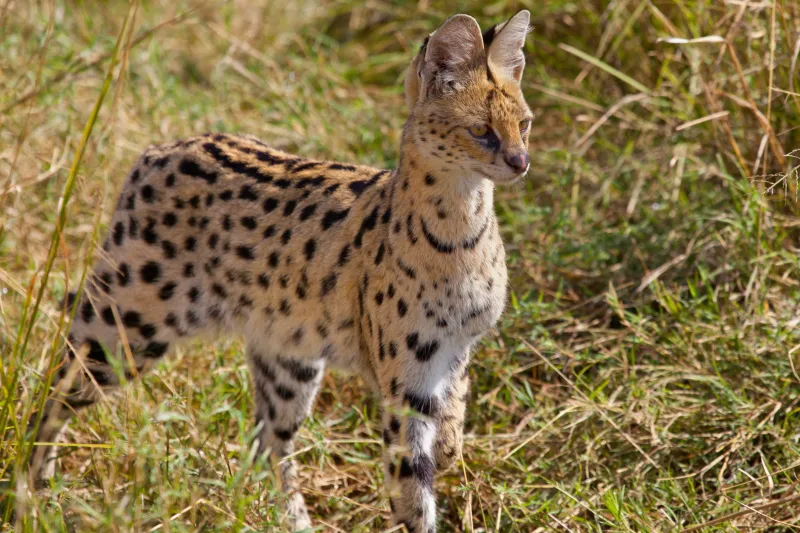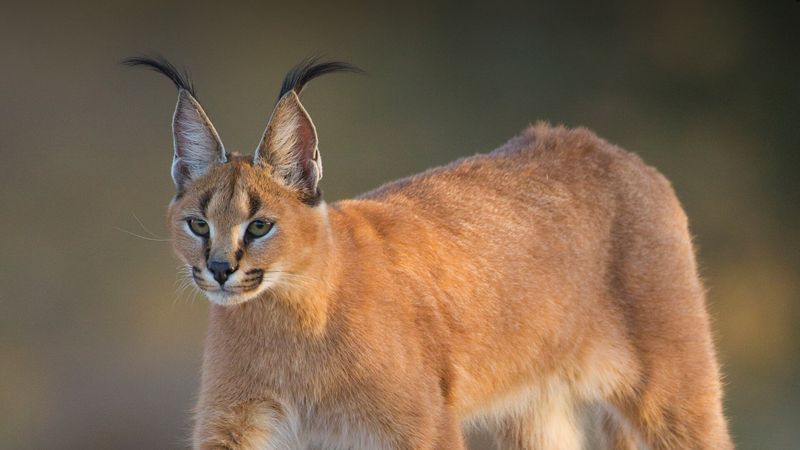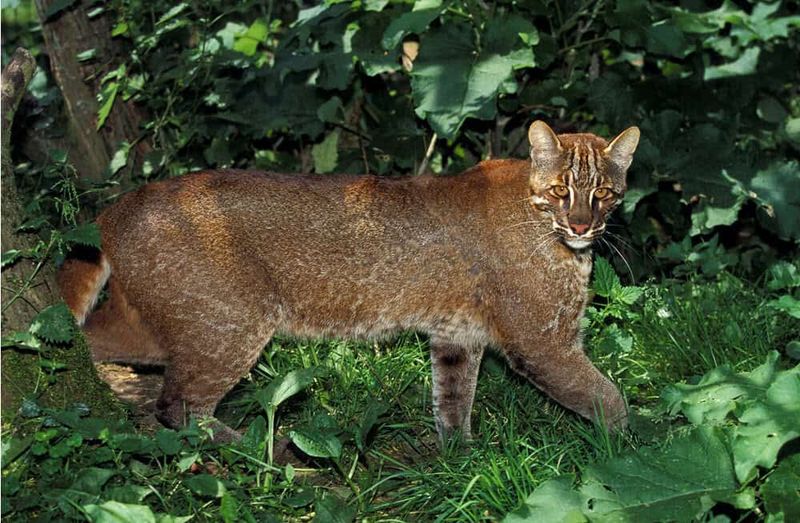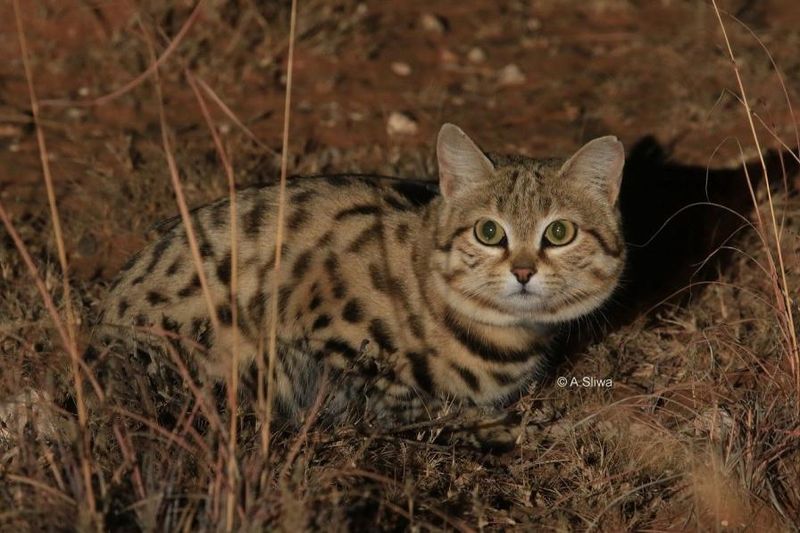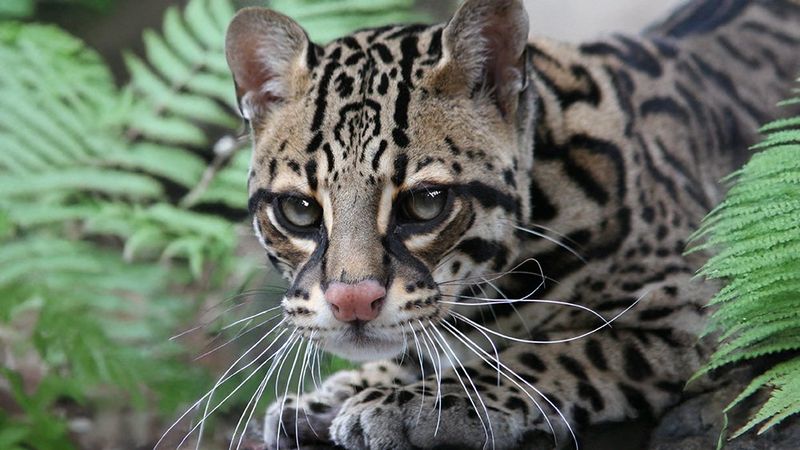📖 Table of Content:
- 1. Rusty-spotted Cat
- 2. Fishing Cat
- 3. Margay
- 4. Oncilla
- 5. Jaguarundi
- 6. Pallas’s Cat
- 7. Flat-headed Cat
- 8. Geoffroy’s Cat
- 9. Kodkod
- 10. African Golden Cat
- 11. Andean Mountain Cat
- 12. Chinese Mountain Cat
- 13. Pampas Cat
- 14. Iriomote Cat
- 15. Bay Cat
- 16. Marbled Cat
- 17. Leopard Cat
- 18. Sand Cat
- 19. African Wildcat
- 20. European Wildcat
- 21. Jungle Cat
- 22. Serval
- 23. Caracal
- 24. Asiatic Golden Cat
- 25. Black-footed Cat
- 26. Ocelot
Wild cats come in all shapes and sizes, and some look surprisingly like the feline friends sleeping on our couches. These wild relatives share many physical traits with domestic cats but live free in forests, mountains, and grasslands around the world. Many of these species remain unknown to most people, despite their important roles in their native ecosystems. Let’s explore some wild cats that could easily be mistaken for pets if you spotted them in the wrong place!
1. Rusty-spotted Cat
Native to India and Sri Lanka, the rusty-spotted cat holds the title of one of the world’s smallest wild cats. Adults typically weigh just 2-3 pounds, making them about half the size of an average house cat.
Their coat features rusty-colored spots on a gray-brown background, with distinctive white undersides. These tiny predators hunt at night, targeting small rodents, birds, and insects.
Despite their adorable appearance, rusty-spotted cats are fierce hunters with incredible agility and climbing skills. Conservation efforts are crucial as habitat loss threatens their survival in the wild.
2. Fishing Cat
Found in wetlands across South and Southeast Asia, fishing cats are specialized hunters that don’t mind getting wet. Unlike most felines, they have partially webbed feet and dense, waterproof fur that helps them navigate watery environments.
Medium-sized and muscular, these cats weigh between 11-35 pounds. Their olive-gray coat displays black spots and stripes, providing excellent camouflage among reeds and water plants.
Fishing cats catch prey by diving headfirst into water or scooping fish with their paws. They’re excellent swimmers and can even swim underwater to pursue aquatic prey.
3. Margay
With large eyes and a stunning spotted coat, the margay looks like a domestic cat but has a unique skill: it can rotate its ankles 180 degrees to climb down trees headfirst.
Weighing 5-9 pounds, margays are slightly smaller than domestic cats. Their golden-brown fur features black rosettes and spots, and they have proportionally larger eyes for night hunting.
These forest-dwelling cats spend most of their lives in trees, rarely descending to the ground. Sadly, habitat destruction and the illegal pet trade have made margays vulnerable to extinction.
4. Oncilla
Also known as the tiger cat, the oncilla resembles a miniature ocelot with its beautiful spotted pattern. This small wild cat inhabits forests from Central America to central Brazil, weighing just 3-7 pounds when fully grown.
The oncilla’s yellowish-ochre coat displays black rosettes and solid spots, with a white underbelly. Its long tail helps with balance when moving through trees and dense vegetation.
These shy, solitary hunters are primarily nocturnal, preying on small mammals, birds, and reptiles. Each oncilla maintains a territory of approximately 1-2 square miles, marking it with scent to warn away rivals.
5. Jaguarundi
The jaguarundi breaks the spotted cat stereotype with its solid-colored coat and unusual elongated body. Native to Central and South America, these medium-sized cats weigh 8-20 pounds with a body resembling a weasel more than a typical cat.
Their coloration ranges from dark brown to reddish-gray, with no spots or stripes as adults. Jaguarundis have short legs, a long body, and a flat-looking head with small, rounded ears.
Unlike most wild cats, jaguarundis are often active during daylight hours. They’re excellent swimmers and climbers but prefer hunting on the ground, targeting everything from rodents and birds to reptiles.
6. Pallas’s Cat
Native to the chilly grasslands of Central Asia, Pallas’s cats have thick, plush fur and round bodies that make them seem cuddly. Their fur density is unmatched, with about 9,000 hairs per square centimeter.
Despite their fluffy appearance suggesting a large cat, they’re actually small, weighing only 5-10 pounds. Their gray-ochre fur features subtle dark markings, while their distinctive flat face and low-set ears give them a perpetually grumpy expression.
These cats don’t chase prey like other felines but prefer ambush hunting from behind rocks. Their stocky build and short legs are adaptations to conserve heat in their harsh environment.
7. Flat-headed Cat
Known for its distinctively flat forehead and tightly spaced eyes, the flat-headed cat lives in Southeast Asian swamps and excels at semi-aquatic hunting.
Small in size, they typically weigh just 3-5 pounds. Their reddish-brown fur appears sleek and close to the body, while their partially webbed toes help them catch fish and crustaceans.
Extremely rare and endangered, flat-headed cats are nocturnal hunters that depend on healthy wetland ecosystems. Their unusual teeth are specially adapted for grasping slippery prey, with backward-facing barbs that prevent fish from escaping.
8. Geoffroy’s Cat
Geoffroy’s cats could easily be mistaken for someone’s spotted tabby pet if found outside their native South American range. These small cats typically weigh just 4-8 pounds, with a beautiful yellow-gray coat covered in black spots and rings.
Their facial markings include distinctive black stripes running from the eyes to the neck. Unlike domestic cats, Geoffroy’s cats have thick, rather stiff tails that help with balance when climbing.
Adaptable hunters, they prey on rodents, birds, and even fish, which they scoop from water with their paws. Despite being hunted extensively for their pelts in the past, their populations have stabilized in many areas.
9. Kodkod
Weighing just 4 to 5 pounds, the kodkod is the tiniest wild cat in South America. It inhabits temperate rainforests in central and southern Chile and parts of Argentina, blending seamlessly with its shadowy surroundings.
Their thick, brownish-yellow fur displays dark spots that sometimes merge into lines, with a pale underside. Kodkods have proportionally large paws and a bushy tail that helps with balance when navigating forest floors and trees.
Extremely secretive, these cats hunt primarily at night, targeting birds, rodents, and reptiles. Habitat loss from logging and agriculture represents their greatest threat, as they require dense forest cover to survive.
10. African Golden Cat
Rarely seen or photographed, the African golden cat is a medium-sized feline from West and Central African rainforests. It weighs 18 to 35 pounds, roughly twice as heavy as your average house cat.
Their coat color varies dramatically from reddish-brown to gray, sometimes with spots or sometimes completely unmarked. Long legs and a relatively short tail distinguish them from domestic cats, along with their muscular build.
Highly adaptable hunters, they prey on everything from rodents to small antelopes. Few people ever see these secretive cats, as they avoid human contact and are primarily active at dawn and dusk.
11. Andean Mountain Cat
The Andean mountain cat ranks among the world’s rarest and least-studied felines. Living at elevations above 12,000 feet in the harsh Andes Mountains, these cats have thick, ash-gray fur with distinctive brown-yellowish bands and spots.
Similar in size to domestic cats, they weigh 5-8 pounds but appear larger due to their exceptionally thick fur and long, ringed tail. Their tail is particularly distinctive, measuring nearly as long as their body with 6-9 dark rings.
Mountain viscachas (rabbit-like rodents) make up about 90% of their diet. With fewer than 2,500 adults remaining in the wild, these beautiful cats face extinction due to habitat loss and superstitious killings.
12. Chinese Mountain Cat
Recognized as a distinct species only in 2007, the Chinese mountain cat highlights how much remains to be discovered about wild cats. Found along the eastern Tibetan Plateau, these sandy-colored cats weigh between 9 and 20 pounds and are taller than typical domestic cats.
Their light brown or gray fur has faint dark stripes on the legs and tail, with a distinctive ringed tail that ends in a black tip. Unusually large ears help them detect prey moving beneath snow or in tall grass.
These cats hunt primarily at dawn and dusk, targeting pikas, marmots, and birds. Rarely seen and poorly studied, they face threats from hybridization with domestic cats and habitat degradation.
13. Pampas Cat
Adaptable to many habitats throughout South America, the pampas cat lives in grasslands, mountainous areas, and forests. Their medium size is paired with diverse coat patterns, ranging from silvery gray to reddish brown, with some having spots or stripes and others not.
Weighing 6-16 pounds, they have stocky builds with thick fur that becomes longer and denser at higher elevations. Their ears feature distinctive white spots on the back, similar to “eyespots” found on some moths and butterflies.
Primarily nocturnal, pampas cats hunt rodents, birds, and reptiles. They’re excellent diggers, often enlarging abandoned armadillo burrows to create dens for resting and raising kittens.
14. Iriomote Cat
Found only on Japan’s Iriomote Island, the Iriomote cat is among the world’s most geographically limited cat species. With a population of fewer than 100, these dark brown cats with black spots weigh between 7 and 11 pounds, about the size of a strong domestic cat.
Their short legs, relatively small ears, and thick tail help distinguish them from house cats. Iriomote cats have partially webbed toes that assist with swimming and moving through muddy terrain.
These adaptable hunters eat everything from fish and crabs to birds and mammals. Conservation efforts include protected habitat zones and wildlife crossings, but their extremely limited range makes them vulnerable to extinction from disease or natural disasters.
15. Bay Cat
The bay cat remains so elusive that scientists have only obtained photographs of living specimens in the wild since 1998. Endemic to the island of Borneo, these medium-sized cats weigh 5-9 pounds and sport a rich chestnut-red or gray-brown coat with faint spotting.
Their round heads feature small, rounded ears and distinctive white lines running from the eyes toward the neck. The bay cat’s tail is relatively thick and marked with dark rings near the tip.
Almost nothing is known about their behavior or ecology due to their extreme rarity and secretive nature. Deforestation in Borneo represents their greatest threat, with population estimates suggesting fewer than 2,500 adult bay cats remain.
16. Marbled Cat
With a beautifully patterned coat, the marbled cat’s large, irregular blotches edged in black resemble marbled paper or the markings of a clouded leopard. This species is found in the forests of Southeast Asia.
Similar in size to domestic cats at 4-11 pounds, they have unusually large canine teeth relative to their size. Their exceptionally long tail, nearly as long as their body, helps with balance when moving through trees.
Marbled cats spend most of their lives in the forest canopy, rarely descending to the ground. Their diet likely consists of birds, squirrels, and other tree-dwelling creatures. Deforestation threatens their survival as they depend on intact forest ecosystems.
17. Leopard Cat
Spanning a vast area from Pakistan to the Philippines and Russia, leopard cats have the broadest range of any Asian small cat. They typically weigh 5 to 16 pounds and are similar in size to large domestic cats.
Their yellow-brown to gray fur displays distinctive black spots and white undersides. Two dark stripes run from their eyes to the back of their head, while their tails show several dark rings.
Bengal cats, popular domestic pets, originated from crosses between leopard cats and domestic cats. Despite their wide range, leopard cats face threats from habitat loss and hunting for the fur trade. They’re excellent swimmers and often live near water sources.
18. Sand Cat
Found across the deserts of North Africa, the Middle East, and Central Asia, sand cats are small felines weighing 3 to 7 pounds. They’re specially adapted for desert life, with hairs on their ears and paws that help keep sand away.
Their pale sandy-colored fur provides perfect camouflage, while black markings on their legs and tail tips add distinctive touches. Sand cats have unusually broad heads with widely spaced ears that help dissipate heat.
Masters of desert survival, they can live without drinking water, obtaining moisture from their prey. Their thick fur insulates against both extreme heat and cold, as desert temperatures can swing dramatically between day and night.
19. African Wildcat
African wildcats look so similar to tabby domestic cats that they’re often mistaken for feral house cats. This resemblance makes sense – they’re the primary ancestor of all domestic cats, with domestication beginning around 10,000 years ago in the Near East.
Weighing 6-13 pounds, these cats display light brown or gray fur with faint tabby markings and a ringed tail that ends in a black tip. Longer legs and a more robust build distinguish them from most domestic cats.
The greatest threat to African wildcats today comes from hybridization with domestic cats, potentially diluting their wild genes to extinction. They inhabit grasslands and open woodlands across Africa and the Middle East.
20. European Wildcat
Resembling large tabby cats, European wildcats have thick coats and bushy tails with blunt ends. Historically common throughout Europe, their populations are now fragmented across Scotland, parts of continental Europe, and Western Asia.
Weighing 6-15 pounds, they’re larger and more robust than domestic cats, with distinctive unbroken stripes on their sides and a dark dorsal line along their spine. Their thick, bushy tail features 2-3 black rings and a black tip.
Primarily nocturnal hunters, European wildcats target rodents, rabbits, and birds. Hybridization with domestic cats represents their greatest conservation challenge, as pure wildcats become increasingly rare in many regions.
21. Jungle Cat
Found in wetlands and river valleys from Egypt to Southeast Asia, the jungle cat prefers habitats like reed beds and agricultural land close to water, not thick jungle forests as its name suggests.
Weighing 11-35 pounds, jungle cats stand taller than domestic cats with longer legs and a relatively short tail. Their coat ranges from sandy brown to gray with few or no markings, though kittens often display faint stripes that fade with age.
Jungle cats are skilled swimmers that don’t hesitate to enter water when hunting fish, frogs, or waterfowl. Their distinctive black ear tufts and short tails help distinguish them from feral domestic cats in their range.
22. Serval
The serval’s extraordinarily long legs make it instantly recognizable among small wild cats. Native to African grasslands and savannas, these distinctive cats stand 21-24 inches at the shoulder but weigh just 20-40 pounds, giving them a lanky appearance.
Their golden-yellow coat displays black spots and stripes, while their small head features oversized ears that can detect prey moving underground. Servals possess the longest legs relative to body size of any cat, allowing them to see over tall grass.
These specialized hunters can leap over 9 feet high to pounce on rodents with incredible precision. Servals are the parent species of the Savannah cat, a popular but controversial domestic hybrid breed.
23. Caracal
Featuring distinctive black ear tufts up to 1.75 inches long, caracals are medium-sized cats that inhabit dry landscapes in Africa, the Middle East, and parts of Asia, weighing from 25 to 40 pounds.
Their uniform reddish-tan or sandy coat lacks spots or stripes as adults, giving them a sleek appearance. Powerful hind legs enable caracals to leap over 10 feet high, allowing them to catch birds in mid-flight.
Ancient Egyptians admired caracals, often depicting them in art and sometimes training them for hunting birds. Despite their impressive abilities, caracals remain secretive and are rarely seen in the wild, though they adapt well to human-modified landscapes.
24. Asiatic Golden Cat
Showing six different color morphs, the Asiatic golden cat lives in forests throughout South and Southeast Asia. These medium-sized cats weigh between 20 and 35 pounds and have a compact, powerful physique.
Their coat colors include golden-red, dark brown, gray, and even melanistic (black) forms. Some populations show spots or stripes while others have uniform coloration. Local names reflect this variety – in parts of China, they’re called “rock cats,” while Malaysians call them “fire tigers.”
Highly adaptable, these cats hunt everything from rodents to young deer. Their territories often overlap with those of tigers and leopards, suggesting they’ve evolved to utilize different prey resources.
25. Black-footed Cat
The black-footed cat holds the title of Africa’s smallest wild cat, weighing just 2-5 pounds. Don’t let the tiny size fool you – pound for pound, these are considered the deadliest cats in the world, with a 60% hunting success rate.
Native to southern Africa’s arid grasslands, they have sandy or tawny fur with black spots and stripes. Their name comes from the distinctive black fur on the undersides of their feet, which helps protect paw pads from hot sand.
These nocturnal hunters make up to 10-14 kills per night, primarily targeting small rodents and birds. Despite their fierce hunting abilities, black-footed cats are incredibly shy around humans and rarely seen in the wild.
26. Ocelot
The ocelot’s spectacular spotted coat once made it a target for the fur trade, with hundreds of thousands killed for fashion. Native to the Americas from southern Texas to northern Argentina, these medium-sized cats weigh 15-35 pounds with a slender build.
Their cream to tawny fur displays elongated rosette patterns and solid spots, with distinctive white spots on the backs of their ears. Ocelots have proportionally large eyes for excellent night vision when hunting.
Primarily nocturnal, they hunt everything from rodents to monkeys and birds. Unlike many wild cats, ocelots frequently use the same trails repeatedly, creating visible paths through their territories. Their name comes from the Aztec word “tlalocelot,” meaning field tiger.
